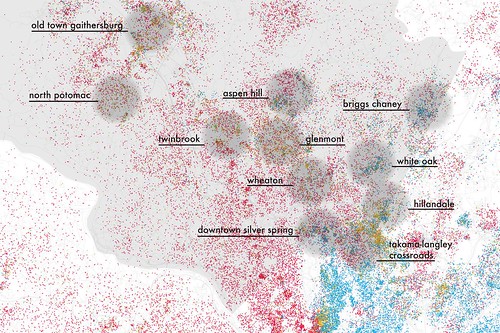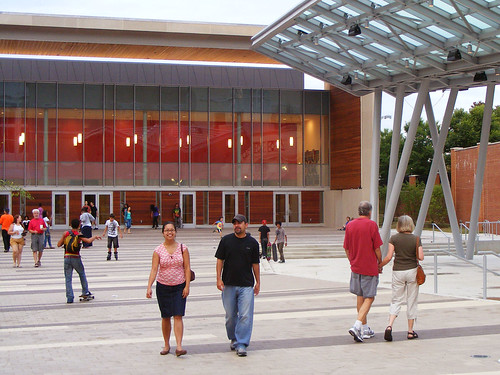
These maps by Eric Fischer representing the ethnic and racial divides in major American cities have been making the rounds on local blogs today, particularly this one of Greater Washington. It's no surprise to anyone in the D.C. area that the city is segregated - until quite recently, whites and blacks generally lived on opposite sides of 16th Street, with some exceptions - but what rarely discussed is how integrated the suburbs are.
For almost forty years, Montgomery County has expressed a commitment to racial and economic diversity through its government policies, notably its Moderately Priced Dwelling Unit (MPDU) program, which provides subsidized housing for low-income households. This map provides some insight into how successful those efforts have been. Red dots represent whites, blue for blacks, green for Asians and orange for Hispanics.
While the District has a fairly strong distinction between white and black neighborhoods, and most of Prince George's County appears to be solidly black, Montgomery County looks like a bowl of rainbow sprinkles. Even areas that have a reputation for housing one ethnic group - Hispanics in Wheaton, for instance - show a far finer-grained mix of people. Save for the Takoma-Langley Crossroads, where you can see a big blob of orange dots (for Hispanics), there are few obvious ethnic enclaves on the map.

Except for white enclaves, of course. The west half of the map - Bethesda, Rockville and Potomac - doesn't look at all integrated from first glance. Nonetheless, there's still some clustering of green dots (for Asians) along Darnestown Road in North Potomac.
This isn't surprising to anyone who attended Wootton High School, which my friends nicknamed "Wonton" for its Asian population, or to fans of Michael's Noodles at Darnestown and Travilah roads in Rockville, "perhaps the best Chinese restaurant in this area right now," according to Tyler Cowen.
The map of Greater Washington also makes a point about how people of all backgrounds choose where to live. For the most part, Asian and Hispanic immigrants have located in Montgomery and Fairfax counties, lured by good schools and easier access to jobs, two things that Prince George's County generally can't promise. Though Prince George's has relied for decades on its reputation as a haven for the black middle class, this strategy has failed to draw investment, whether in the form of newcomers to the county, the region and this country.
So far, I haven't found any suburbs in Philadelphia as diverse as those I've found in the D.C. area, though the psychology of how different races and ethnicities land where they do is complicated everywhere. American University professor Sheryll Cashin explores this in the book The Failures of Integration, which is a must-read for anyone interested in that topic.

3 comments:
@Dan,
I'd be very interested in seeing an overlay over that map showing income distribution. One reason people choose to live where they do is because of socio-economics. There is a correlation between that and race, but if the root cause is socio-economic and not race, then you come up with different ways of getting more integration.
For instance, if the assumption is that people of different races just don't want to mix, then that's how you get a solution like forced busing of students to schools far away. If the assumption is that money is the main reason that people live where they do, you develop policies to more evenly distribute incomes. MPDUs are one way to encourage better socio-economic integration.
Better zoning that allows for more kinds of housing also helps. Mixed-use development also helps spread out businesses and housing, creating more areas that are considered desirable.
Getting back on topic, one reason I think you see more diversity in Montgomery County is that it's an easier place for people in the middle class to live in than DC. The middle class is the most diverse. In DC, you find many people who are quite well off and others who are very poor.
It's not easy to live in DC and be middle class.
I like Silver Spring, and think it is a place with a lot of potential for smart growth. It's kind of like being on a young sports team with talent, but that still needs several years of seasoning and good coaching to really harness its potential.
That being said, if money were no object, I'd probably consider living in other areas in the region. But since money is an object, Montgomery County, specifically, DTSS made the most sense to me.
Philadelphia's Pennsylvanian suburbs are almost exclusively white (based on experience and fact. Heading into the New Jersey side of the burbs, particularly in Camden, and you find more diversity. Within the City of Philadelphia occurs a drastic change from black to white neighborhoods heading into Northeast Philly. It's quite astounding that a street, in this case Cottman Ave, can mean so much.
I recall when Prince Georges County was made up of white right leaning catholics.
Langley park was predominantly Jewish.
Capitol heights was predominantly white.
Montgomery County in 1960 was not only very white- they use to hold Klan meetings at Wheaton Regional Park.
When my family moved to Montgomery County from D.C.- we use to have some our black friends over for cookouts.
Quite a few times my parents and my siblings were called n-----lover.
Things have really changed.
Bob Fustero
Post a Comment